Lupine
Publishers- Environmental and Soil Science
Abstract
Investigating the breeding population and soil texture of breeding sites of four Terns, Crab Plover, and Western Reef Heron
on the islands of Khan, Nakhilou, Om-al-Gorm, and Tahmadon in Mond Marine National Park in Persian Gulf carried out in the
spring and summer in 2015. Twenty-two species of water birds identified on the islands. Eight species of them were breeder and
reminder (14 species) was passage. The dominant species was Bridled Tern Sterna Anaethetus with 170427 breeder pairs that had
bred on sandy ground under the Atriplex bushes. The populations of Lesser Crested Tern Sterna bengalensis and Greater Crested
Tern Sterna bergii were 19933 pairs in Nakhilou and Om-al-Gorm Islands that had bred also on the Sandy ground. The breeder
population of Western Reef
Heron Egretta gularis was 12, 72, and 45 pairs in Om-al-Gorm, Nakhilou, and Khan Islands respectively.
The nests have been built on the short bushes. The breeder population of Crab Plover
Dromas ardeola
was 2266 on Nakhilou and
481 on Om-al-Gorm. The nests of this species have been built under
ground in tunnels. Soil texture of tern’s nests sites in Nakhilou,
Island consisted of 94.6% sand, 1.3% silt and 4.1% Clay, and under
Atriplex bushes was 95.4% sand, 1.7% silt and 3.9% Clay. Soil
texture of terns nesting sites in Om-al-Gorm, Khan, and Tahmadon
consisted of 93.4% sand, 1.7% silt, and 4.9% clay; 92.8% sand,
2.7% silt and 4.7% clay, 89.4% sand, 3% silt and 7.6% clay respectively.
The soil texture of the nesting sites on four islands did not
differ significantly (p=0.05).
Introduction
Tern’s species make nests on the ground [1-3] so soil texture
is essential for nesting and protecting chicks. Iran, with its 105
important bird area (IBA) for native and wintering and breeding
birds ranked first in the Middle East [4]. Accordingly, it is important
to study the habitats of breeding species. Soil structure and
vegetation studies of breeding habitats are important for long
term identification of factors affecting reproductive successes,
demographic trends, conservation and management plans for
breeding species and sites [5-8] Many of the Persian Gulf islands are
sensitive habitat for breeding seabirds and have been continuously
changing since decades ago as the most important habitat for
the reproduction of terns species, Crab Plover and Western Reef
Heron [9,10]. These changes have increased in recent years due to
developing in the islands. The islands of Khark, Kish, Lavan, Siri, and
Qeshm are among the islands that are no longer suitable habitat
for reproduction for seabirds Sea birds had bred on these islands in
1970s [11,12]. Perhaps we will see similar events in the islands of
the MMNPI in the near future. The four-small sandy, inshore islands
with extensive intertidal mudflats in the northern Persian Gulf,
extremely important for breeding and wintering habitat seabirds,
these islands located in (MMNPI) in the Bushehr province, which
annually produce tens of thousands of terns of different species.
Despite the great value and importance of the islands in preserving
the generation of tern, shore birds, and sea turtles, unfortunately,
little research has been carried out on this issue. The lack of
awareness and understanding of environmental managers of the
importance of the natural environment of the islands has limited
their conservation process. So far, there has been no investigation into
the identification of habitat selection by breeding Terns species
and soil structure in the breeding habitats in the four islands of the
(MMNPI) in Bushehr province. Few studies have included counting
and identifying breeding seabirds, and sea turtles. The islands of
Om-al-Gorm, Khan, Tahmadoun, and Nahilou were declared as an
important breeding habitat in 1994.Tuck performed studies on
Persian Gulf birds in 1974 [13]. In 1985, the habitat conditions
for the reproduction of tern’s species on the islands are said to
be sandy-clay soils [14]. In 1998, Snow and colleagues carried
out research on tern’s species, and they reported that terns are
reproducing on the islands on sandy-clay soils [15]. In 2005 and in
2002, sandy habitats were also described for breeding terns [16].
Scott in 2008 lists the status of rare birds in Iran, including the
breeding species on the Persian Gulf islands [17]. In 2008, studies
have been carried out in relation to nest counting of four species
of terns and Western Reef Heron on the 10 Island in Persian Gulf
[18,19]. In 2008, Persian Gulf water birds, including the islands of
Bushehr Province, have been published in the book of Dictionary
of Persian Gulf Water birds [20]. In 2002, coastal bird population
and breeding studied by Aspinal [21]. By reviewing the published
articles, it is clear that the soil texture of tern’s species
reproduction
sites in Persian Gulf Islands has not been studied. The purpose
of this study was to determine the breeding population of four
tern’s species, Western Reef Heron, Crab Plover and soil texture of
breeding sites of breeding species in four islands in (MMNPI).
Materials and Method
Study Area
There are four islands called Om-al-Gorm,
(55o27’E33o51N’) Khan (Um-al-Sileh) (29o27’N16o51’)
Nakhilou (27049’19”N54051’28”), and Tahmadon (Gabarin)
(24o51’28”N50o27’12”E) in the (MMNP) (Figure1). Four small
sandy inshore islands with extensive intertidal mudflats in the
northern Persian Gulf are extremely important for breeding Crab
plover, Western Reef Heron, tern’s species and also important
for nesting sea turtles [22]. The islands are located at a distance
different from the coast and almost along each other. The climate of
these islands is warm and humid. The average annual temperature
is 26 °C, the average air pressure is 1008.6 H.P., the average relative
humidity is 62%, and the average annual precipitation is 220 mm.
The average annual rainfall is 56 days, mostly in the autumn and
winter (Office of Meteorology of Bushehr Province, 2015). None
of the four islands are inhabited. But fishermen stay at the nights
during fishing seasons [23,24]. Due to the proper texture of the soil,
massive vegetation, the richness of the surrounding waters of the
food and the absence of natural predators, these islands are a safe
and suitable environment for the nesting and egg lying for aquatic
migratory seabirds as well as sea turtles. But terns, Crab Plover
and Western Reef Heron are considered to be the most important
habitat for the islands [10,12].
Figure 1: Location and vegetation cover of Islands in Mond Marine National Park in Persian Gulf (Google Earth, 2015).
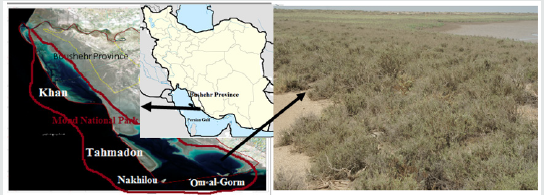
Data Collection
The study period on (MMNPI) ran from March 2015 to
September 2015, in the nesting period of six tern species, Crab
Plover and Western Reef Heron. We used Binocular 10× 40 Zeiss and
a telescope 15×60 to identify the birds and the total count method
to count the all species of breeders. Six tern’s species Lesser Crested
Tern, Greater Crested Tern, Caspian Tern, Little Tern, and Whitecheeked
Tern were nesting in open fields with sandy soils (Figure
2). The Crab Plover nest in the form of a tunnel in the sandy soils
counted by total count Method also. The Bridled Tern nests were
under the shade of the Atriplex bushes and nests were counted by
lifting the branches of the Atriplex.
Figure 2: Nest site of Lesser Crested and Greater Crested Tern and Bridled Tern on Nakhilou Island in 2015.
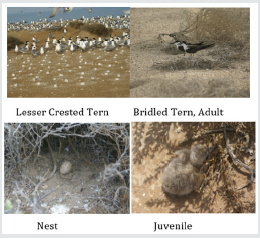
Soil Texture of Islands
Soil texture is determined by hydrometric method. In this study,
152H-62 hydrometers were used to determine soil texture. The
basis of this is the measurement of the density of the suspension
of soil and water, which gradually decreases due to the deposition
of the material, and the hydrometer falls further in the liquid. The
numbers read on the hydrometer are proportional to the volume of
fluid displaced [25].
Chemical Parameter of Water
PH, EC, TSS, TDS B.O.D., C.O.D., T.H. NO3, PO4, and TS have been
measured in spring and summer according to Standard method
2005 [26] for the determination of chemical parameters of around
water of island by certified laboratory.
Result and Discussion
The Terns, Gulls, and shore bird’s species of the four islands
were identified in spring and summer in 2015 (Table 1). The most
species were identified on the Om-al-Gorm Island (20 species) and
the least species on the Tahmadon Island (11 species). Fourteen
species were identified on Nakhilou and sixteen species on Khan
Island. Seven species were seen on each of the four islands, and four
species only on one island (Table 1).
Table 1: Water birds recorded on 4 islands in the spring and summer in 2015.

Breeding Species
Seven species of birds had bred on 4 islands (Table 2). Breeding
species migrate to the islands and breed which have enough security
and other environmental factors. After breeding they leave islands
end of summer. 94% of birds had bred on the island of Nakhilou
and 6% on the other three islands (Figure 3). The Bridled Tern has
a large population and has bred on Nakhilou Island (12521 pairs).
Only three pairs of Little Tern have bred on Nakhilou. Lesser Crested
Tern was the second with 123 breeder pairs (Figure 4).
Figure 3: Breeding population percent on four Islands in 2015.

Figure 4: Number of breeding species reported on four islands in 2015.
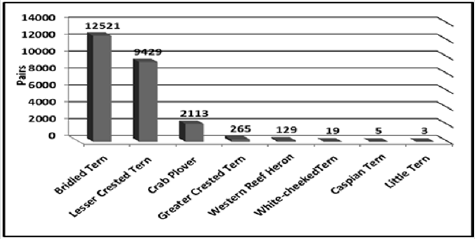
Table 2: Breeding species counted on the four islands in 2015.
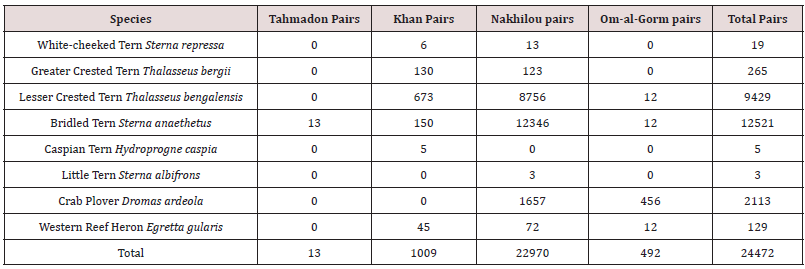
The Habitat Conditions of the Islands
The habitat conditions of the four islands that are used by
breeding terns and other species are shown in Tables 3 & 4. Table
3 show that the soil texture of the islands in the breeding sites
of seabirds has a sandy structure with an average of 93% of the
sand. Perhaps because of the softness of the soil, easy nesting,
conditions for the survival of newborn chicks are appropriate.
Most of tern’s reproduction has been reported on open area among
density vegetation coverings. The salinity of the surrounding water
of islands near the colony of nests was 38.5 mg/l. The Atriplex
species are dominant in each of the four islands, and the
Tamarix
sp, Chenopodium murale, Suaeda vermiculata, Ephedra foliolata,
Cyperus conglomerates, Lycium edgeworthii, Bromus japonicas,
Limonium iranicum, Cistanche tubulosa, and
Stipa capensis are seen
on each of the four islands, but their densities are higher in Nakhilou
and Om-al-Gorm than Khan and Tahmadon. The vegetation of the
various parts of the islands varies from 30 to 90 percent (Figure
1). Table 4 shows the chemical parameters of water at around of
the islands is similar to Persian Gulf waters, and also there was no
significant difference (P=0.05) between the chemical parameters of
four islands.
Table 3: Soil texture of nesting sites on four Islands in 2015.
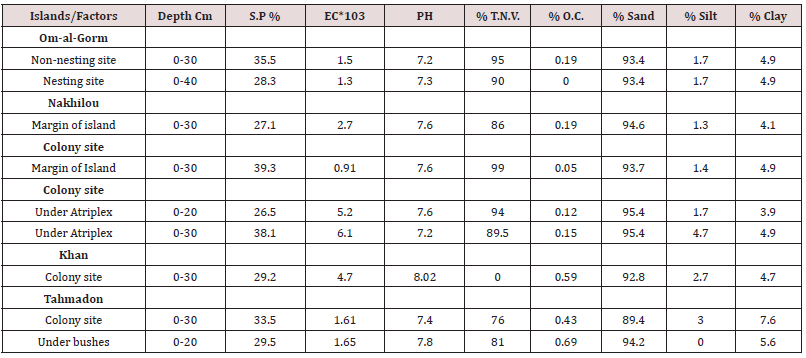
Table 4: Water parameters of islands in spring and summer in 2015.

Soil Texture of Islands
Soil Texture of Om-al-Gorm
The shape of the island is arched and in the form of a half circle
with its convex side facing south. The origin and structure of the
island is the result of the collision of the sea floor irregularities
with the sedimentation of the water entering the Mond River in the
northeast of the island to the sea. In terms of its topography, there
are no significant natural complications. Only in the middle part
of the south and southwest of the island there are low-lying sand
dunes (up to 2 meters). Soil texture of island is fine sand gravel,
particularly in the west and southwest with shellfish, resulting in
a kind of coarse-grained and distinct texture. Two soil samples
were taken from the soil to compare the differences in the texture
structure nesting sites (Table 3). Tern’s species nesting sites
were with sandy soil structure with more than 93 percent sands
(diameter 0.02-2 mm) and no specific building. These parts are
lacking vegetation. Soil lime (Ca, MgCo3) was about 93.4%, which
causes the soil texture to be slightly tight. Electrical Conductivity
of Saturation percent is about 1.3 Ds/m, PH was 7.3, the amount
of organic matter in this part of the soil was zero, and the moisture
was 35.5%. Soil drainage is very good, and its permeability is high.
These types of soils are suitable for the nesting of Crab Plover. Soil
margin structure of the island contains a lot of shellfish. There is
moisture in this area, and drought-tolerant plants have an annual
growth. The soil texture is sandy (93.4%), with a saturation of
28.3%, an electrical conductivity of 1.5 DS/m and a saturated
acidity of 7.2. The equivalent amount of lime in this part is 95% and
organic matter content is about 0.2%, which is due to plant remains
(Table 3).
Soil Texture of Nakhilou
The island of Nakhliou, in terms of its origin and structure,
has the same conditions as the island of Om-al-Gorm. Nakhilou,
the westernmost of the islands and the furthest offshore, is a
small, almost circular island of about 35 ha, comprised mainly of
sand with some rocky shore in the south and west. Soil texture
of island is fine sand gravel, particularly in the central parts with
shellfish (Figure 5). There are two small brackish pools near the
south end and Shiekh Karameh grave near the west coasts. The
island is fringed with low sand dunes which encircle a central
basin almost completely covered in dance, low scrub. The island is
without inhabited. The soil structure of the island is twofold due
to the presence of bivalve and gastropod shellfish, depth of soil
and low elevations and soil color. The central part of the island,
with its shellfish’s, is a sandy soil structure, and the margins of the
island, where the amount of shellfish is much more, and the color
of the soil is white. In the central part of the island, the plant has
become densely populated with Atriplex species and some other
species. Soil characteristics of the breeding sites are sandy. The
large amount of feces of breeding birds accumulated in this area
and caused a slight soil hardening. Overall, the thickness of the (A)
layer is about 2 cm. Its electrical conductivity is 5.2, sand 92.6%
and organic matter is 0.12%, while the amount of sand under the
Atrepilex is 88.4%, there are some plant leaves, organic matter is
0.15%, and electrical conductivity is 9.1 Ds/m (Table 3).
Figure 5: Sugar beet leaf spot disease (
Cercospora beticola Sacc.).
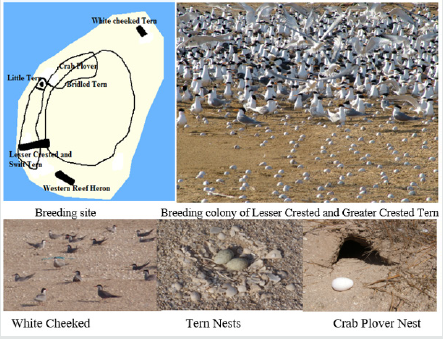
Soil Texture of Tahmadon (Geberin)
The area of Tahmandon Island is between 700 and 1000
hectares. Its shape is triangular and its distance from the coast is
about 300 meters. More than four-fifth, of the island, goes under
water when it is high tide. The conditions for the formation of the
island are similar to the other three islands. The central parts of the
island are submerged by two canals in the tide and soil texture of
this part is salty. Characteristics of both soils are shown in Table 3.
Due to under watering a large part of the island, the birds do not
breed in it. Because most of the time, surface is often muddy and
wet.
Soil Texture of Khan (Um-al-Sileh)
Khan Island is a long narrow island consisting of a broad
expanse of bare mudflats with a chain of low vegetated sand dunes
along its southwestern (seaward) margin and round the southern
end. The dunes are separated by narrow tidal channels which open
into a chain of shallow lagoons on the mudflats on the landward
side of the dunes. The area of the island varies and reaches 1000
hectares. At the time of the low tide, the island is connected to the
land. Its geographic location is 29o 27’N51o 22’E (Figure 1). It is
surrounded by mudflats and the surrounding waters are very
shallow. The island has very little vegetation, but the trunks and
shrubs of many trees have been brought to the island by the Mond
River. The soil texture is sandy, and its sand is 92.8 percent (Table
3). Island soil is classified in the group of saline soils. Due to the
drowning of the island during the time of the high tide, the nests of
Terns are destroyed, or their eggs breaks down, which makes the
birds less nest on the island.
Chemical Parameters of Water
Chemical parameters of water around of 4 islands have been
showed in Table 4.
Breeding Sites of Birds on Islands.
Nesting Site of Lesser Crested and Greater Crested Tern
The Greater Crested (Swift Tern) and Lesser Crested Tern
breed in mix colony with together and breeds on many islands in the Persian Gulf including Shidvar, Khabre Nakhoda, Boneh, Dara,
Banifaror and (MMNPI) [18,19]. The nest is a shallow scrape in
the sand on open, flat, or occasionally sloping ground. It is often
unlined, but sometimes includes stones or shellfish. The breeding
places of these species have a sandy soil (Figure 5). As shown in
Table 3 soil texture of the nesting site of these species in 4 islands
of (MMNPI) are sandy and the soil texture has more than 90% sand.
Because these species do not use materials in building nest, they
put eggs on the soft ground with sandy soils. Figures 2 & 5 shows
nest of Lesser Crested and Greater Crested Tern on the Nakhlou
Island. Bridled Tern occupied the central part of the island and
other species bred on margin of island. Western Reef Heron on
Short bushes and the Lesser Crested and Greater Crested Tern on
sandy soil and Crab Plover in tunnel (Figure 6). Breeder species on
Om-al Gorm were Bridled Tern, lesser Crested Tern, Western Reef
Heron (each of them 12 pairs) and Crab plover (456 pairs, 2%) in
2015. Crab Plover had bred on three colonies (Figure 6) and (Table
2).
Figure 6: Nest sites of Crab Plover, Bridled Tern, Lesser Crested Tern, and Western Reef Heron on Om-al Gorm in 2015.

Figure 7: Breeding sites of Lesser Crested and Greater Crested Terns, Western Reef Heron and Bridled Tern on Khan Island
in 2015.

Conclusion
The nest of Lesser Crested and Greater Crested Terns were a
shallow scrape in the sand on open, flat on the four islands. It is
often unlined, but sometimes includes stones or a few shellfish [27].
The data obtained showed that the Bridled Tern breed in covered
vegetation parts on the islands. This species was only species that
had bred on four islands, because all islands have proper vegetation.
Density of the vegetation on Khan Island is lower than the other
three islands and Atriplex sp is not dominant. The Bridled Tern
creates the nest in the shade of Syperus on Khan. The soil texture
in this place is sandy also. The amount of sand in the soil texture
is more than 90 percent and soil are very soft in all islands in
nesting sites. Due to the presence of massive vegetation (Atriplex)
in the Nakhilou Island the dominant species of breeding seabirds
was Bridled Tern with a population of 12346 pairs. Small sandy
dunes near the sea are nesting sites of Lesser Crested and Greater
Crested Terns. Breeding population of these two species were 8872
pairs on the Nakhilou Island. On the Thamadon Island there was
a small colony of Bridled Tern (13 pairs) in 2015 (Table 2). White
cheeked Tern was other breeding species on the Nakhliou Island,
which nested on the beach of the Island near water with shellfish
(13 pairs) (Table 2). Nests were bowl-shaped and have distinct
buildings (Figure 5). The soil surface of this area of island is covered
with shellfish and its texture is rough. On the island of Nakhilou
and Om-al-Gorm, 2113 pairs of Crab Plover had bred (Table 2).
The nest of this species is different from the other breeding species
in the islands. This species dug a tunnel for nest, is about 1 to 1.5
meters long, so it needs to have a soil texture that is a bit tight and
usually there is little vegetation on the surface of the soil. The roots
of the vegetation help to tighten of soil structure so, the nest does
not crumble during breeding period. On the other hand, the soil
texture should be soft that Crab Plover can dig the tunnel. These
conditions exist among the open vegetation spaces of all 4 islands.
But other environmental factors needed to survival of chickens,
such as security on the two islands of Tahmadoun and Khan, are
not provided enough.129 pairs of Western Reef Heron had bred
on Khan, Nakhilou and Om-al-Gorm (45, 72, 12 Pairs respectively).
This species was made on the two islands of Nakhihou and Umal-
Gorm on the Atriplex shrubs, but on the island of Khan on the branches
of the trees that brought water to the island. The structure
of the nests is not directly related to the soil texture. Only 13 pairs
of Bridled Tern have been bred on Tahmadon Island in 2015, on
central parts of island under the small bushes. Table 3 shows soil
of breeding sites of Lesser Crested and Greater Crested Tern has a
sandy structure that is consistent with the findings of Flasola and
Canova in 1991[28]. Terns preferred to nest in the middle third of
the beach, on areas with shell cover, and on ridges and slopes. On
sparsely vegetated beaches, nests were closer to vegetation than
were the random points; on heavily vegetated areas, nests were
further from vegetation than were the random points. In the study
of the habitat selection of Terns, they have also described these two
species breed on the sandy soil’s islands [8]. Lesser Crested and
Greater Crested and Bridled Terns breed in mixed large colonies
[21,29,30]. This finding confirmed the results of studies in the
four islands of the (MMNPI). Behrouzi-Rad in 2008 and Behrouzi-
Rad and Tayfeh in 2008 reported that tern’s species breed in large
colonies on sandy islands in Persian Gulf [9,18]. Scott reported
breeding population of terns on Mond National Parks sandy islands
were 15000 pairs in 2007 [11, 12]. Breeding four species of terns
reported by Symens and Alsuhaibany on southern sandy island of
Persian Gulf in 1996 [27]. Therefore, tern’s species in the Persian
Gulf islands in the open areas of vegetation breed on sandy soils.
In the soil analysis, the amount of sand in each of the four islands
with an average of 93.4% in Om-al-Gorm, 94.7% in Nakhlilou,
92.8% in Khan and 91.8% in Tadamond, was not significantly
different. Analyzing the amount of silt and Clay in 4 islands showed
no significant difference among them(p=0.05) (Table 3) Therefore,
terns and Crab plover prefer sandy soils for breeding, but the
number of species, density, and reproductive population in the
islands are related to other environmental factors such as security,
vegetation percentage, etc., which need further investigation. The
four islands of (MMNPI) were introduced in 1994 as important
bird area (IBA) [4]. The islands became known as sensitive habitats
for breeding terns, Western Reef Heron and Crab plover in 2008
[10]. Other tern species like Sooty Terns [8], Yellow-billed Tern and
Large-billed Tern [31] and whiskered Tern [32] breed on bare sand
or in sites with sparse, low vegetation. The study of breeding access
illustrated that area has a good stability in environmental condition,
availability of food, nest sites, and lack of natural predators for
a variety of birds such as terns, Crab Plover and Western Reef
Heron. Besides terns, some terrestrial animals also inhabit the
islands. These include a considerable variety of insects and spiders,
which have not been studied in any details, a couple of species
of lizards, and mice. The sandy and rocky beaches of the islands
support the same of type organisms of Persian Gulf. Conspicuous
among beach animals are the tower-building ghost Crab Ocypode
saratan on sand beaches, and turban snails Turbo species on the
algae-covered rocks. Several species of intertidal animals which are
either uncommon or absent on the mainland beaches are abundant
on the islands. These include the Large Rock Dwelling Crabs
Eriphia
sebana smitbii and
Grapsus tenuicrustatus, frequently seen running
about the exposed rocks at night. Another beach animal common
on the islands is large terrestrial Hermit Crab
coenobita species
feeding on algae. However, their plant and animal population are
rich and unique, and are exceptionally beautiful and instructive
as well as being of great scientific interest. Also, they represent a
valuable, fragile, and irreplaceable resource, where preservation
for the benefit, enjoyment, and instruction of future generation
will demand increasingly careful attention in the face of the rapid
development of industry, population, and recreational activity now
taking place in some islands. However, for these reasons this area is
under Department of Environment, Iran, and Marine National Park
List and is protected.















No comments:
Post a Comment
Note: only a member of this blog may post a comment.